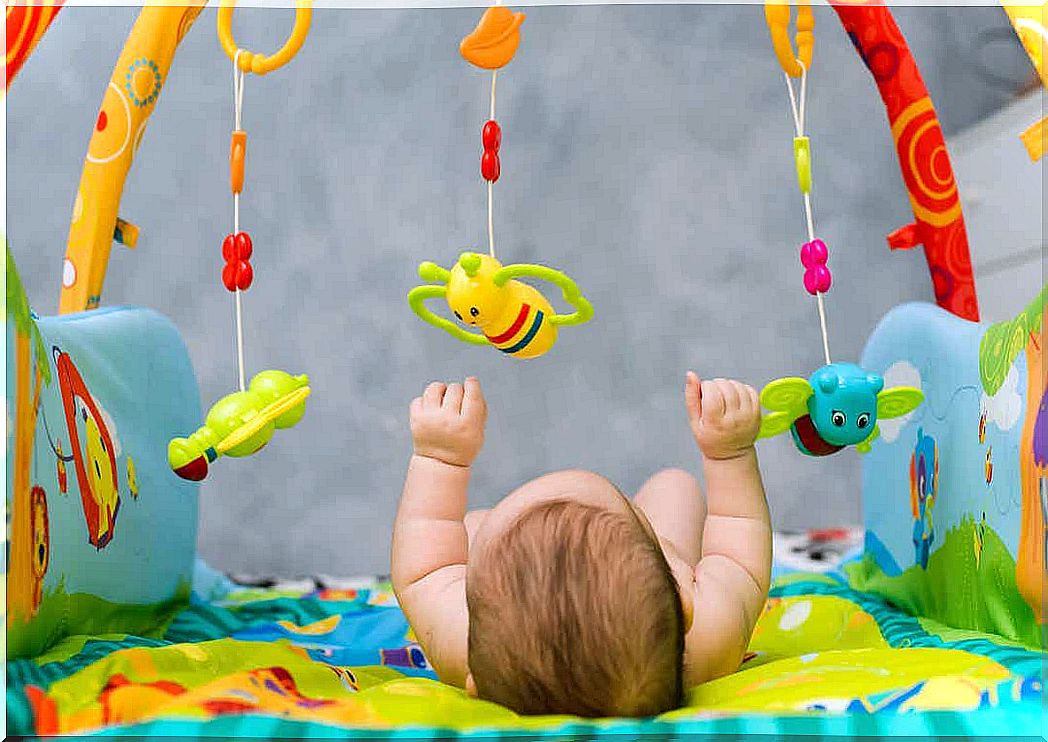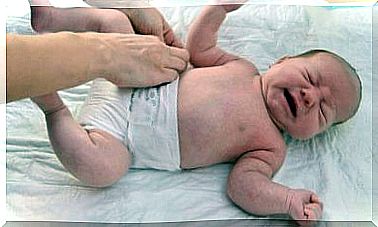Tips To Stimulate A Baby’s Visual Ability

Sight is one of the least developed at birth. That is why it is so important to stimulate a baby’s visual ability.
Children are born with difficulty focusing. But after a few months of intense learning, they do quite well by mimicking movements, recognizing faces, and interacting with them.
Babies are attracted to objects with great contrast, rounded shapes, movements and voices. Early stimulation provides security by helping them find and recognize their caregivers. Visual communication comforts them and connects them with others.
Undoubtedly, stimulation is necessary for reasons which we will explain later. In the first year, the pace of a child’s cognitive experiences is staggering.
What does a newborn’s vision look like?
Newborns come into the world with the right vision to hold on to life closely and personally.
In the foreground, they see their mother, who about 25-30 cm away looking at them, smiling and breastfeeding. Farther away , their blurred vision frees them from understanding what is going on around them, to concentrate only on what is close and vital.
The baby’s gaze at birth is directed at the mother, at the rounded shape of her face, at the contrast of her eyes, at her voice. Also by the dark color of the nipple. It is this first glance that makes us parents.
In the article ” La regard du naissant “, pediatrician Marc Pilliot refers to it as a “basic gaze”. In other words, it is a bridge to the life that has just begun.
Because of the darkness in the womb they left, babies do not like light. If they follow something with their eyes, they follow it sideways, not up and down. In addition, they look at the edges and not at the center.

You may be interested in: Gastroschise in Newborns: A Dangerous Birth Defect
Tips to stimulate a baby’s visual ability
In general, we should not force children to perform any activity. They learn solely by playing in an environment of harmony, joy and tranquility. If you notice that they are annoyed, it is because they do not enjoy what is going on.
Early stimulation
From pregnancy, the mother has a close and intimate relationship with her unborn child. The fetus hears the murmur and voices that it encounters again at birth. This is exciting for them. Numerous studies show that the prenatal relationship is crucial for the development of the mother-baby bond.
From the moment the baby’s eyes open and the initial exchange of glances that build the foundation of the relationship begins, it is actually possible to stimulate the baby’s visual ability. Smells and colors plus the warmth and softness of the mother’s skin prepare the baby to begin the instinctive adventure of life.
Stimulating a baby’s visual ability: Strengthen the contact
The visual relationship between mother and child is intense and will be the guiding thread for the other stimuli. The conditions that the eye establishes with objects will mobilize the hands and the body.
The coordination of eyes and hands is structural and will determine the baby’s progress in neurological development. If the mother does not look at the baby at the moment she is breastfeeding, the baby will lean forward and try to restore contact. If they do not succeed, they can cry.
Another element that strengthens the contact is the woman’s own education and enlightenment. In this regard, sensitive mothers are more likely to adapt their behaviors to the stimulation, regulation, and communication needs of their babies.
Encouragement of curiosity
There is no doubt that the engine of knowledge is curiosity. In children, it is what mobilizes the whole learning system.
The environment that babies visualize, which is close and in motion, steers the child toward survival and protection. Biologically, they are attracted to faces because especially faces are what they focus on the most.
Then they are attracted by luminous forms that reproduce organic sequences and rhythms. Attracting their curiosity, making them follow objects, making them appear and disappear are all part of the training in their ability to search and remember. And these exercises are part of neuroplasticity.
The benefits of stimulating the child’s visual ability
Visual acuity begins around the age of three months and increases until the age of six months. By then, it is already close to reaching the values of adults’ field of vision, although it is possible to stimulate a baby’s vision from birth.
A key element of the stimulation is the possible early detection of vision problems. In fact, it is possible to diagnose them before the age of one year.
For example, in children under thirty days, it is possible to determine whether they are correcting and following their gaze on a moving object of interest. The test will not be decisive until the age of three months. However, if the child is unable to do this, they should be evaluated by a specialist.
As the latter, stimulation leads to body consciousness, which is the basis of spatial consciousness. This in turn is based on auditory and tactile development.

Learn more: How to choose the best school for your child
Stimulation of a baby’s visual ability: The earlier, the better
By the 25th week of pregnancy, the fetus has hundreds of billions of neurons, but only some are connected at the time of birth. From birth to three years, it then becomes integrated through networks and connections.
That is why early stimulation with music therapy is so important from the womb and up to 6 years. Exercises and games that activate their sensory, intellectual, motor, emotional and social development are key. Voices and sounds, caresses, colors and movements are also elements that generate nerve connections in their brain.
In conclusion, sight is one of the senses that needs to be stimulated as quickly as possible. Remember that it is during the first four months that vision and its corresponding neurological circuits develop.









